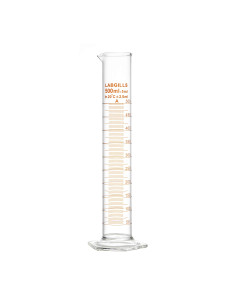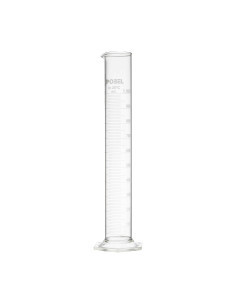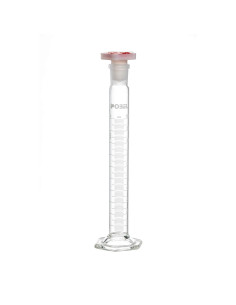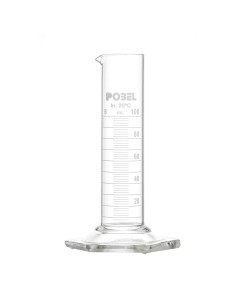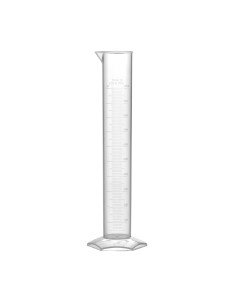Laboratory measuring cylinders are essential tools in any scientific environment, whether in chemistry, biology and physics laboratories or in various industries. These graduated cylinders are designed to measure liquid volumes with high precision, a crucial factor in experiments and processes where accuracy is a must. In science and academia, the ability to measure and transfer accurate liquid volumes is a basic need that directly influences the reliability and reproducibility of experimental results.
What are cylinders like?
Laboratory graduated cylinders are characterised by their cylindrical and elongated shape, which allows precise measurement of the volume of liquids. The base of the graduated cylinder is wide and stable, designed to prevent accidental tipping during use. At the top, they usually have a spout to facilitate the controlled pouring of liquids.
Materials
Borosilicate glass 3.3: Borosilicate glass is known for its high resistance to thermal and chemical shocks, making it ideal for use as laboratoryware. In addition, the clarity of borosilicate glass allows easy reading of graduations, which is essential for accurate measurements. Its resistance to sudden temperature changes ensures that specimens maintain their structural integrity even under extreme conditions. Borosilicate glass 3.3 is also highly resistant to chemical corrosion, which prolongs its life and maintains its accuracy over time.
Polypropylene (PP): This plastic material is chemical and impact resistant, suitable for situations requiring greater physical strength. Polypropylene is lightweight, making it easy to handle and reducing user fatigue during prolonged use. In addition, it is autoclavable, allowing it to be sterilised at high temperatures without compromising its structure. The material is resistant to deformation under mechanical stress, ensuring that the specimens retain their shape and functionality even after repeated use under demanding conditions.
What are cylinders for?
Cylinders have a wide range of applications in various scientific and industrial sectors:
Liquid volume measurement
Chemical laboratories: in chemistry laboratories, test tubes are essential for measuring reagents and solutions accurately. This precision is crucial to ensure that chemical reactions are carried out correctly, which in turn guarantees the reproducibility of experiments.
Pharmaceutical industry: in the manufacture of medicines, it is vital to measure and mix ingredients accurately to ensure the correct dosage and efficacy of the final product. Test tubes play a crucial role in this process, allowing manufacturers to maintain high quality standards.
Biological research: In biology, test tubes are used to prepare solutions and culture media, as well as to measure biological fluids such as blood and serum. Accuracy in these measurements is essential for research and development of new treatments and drugs.
Education: In education, test tubes are essential tools for teaching students the basic principles of liquid measurement and handling. They provide a practical way to learn about volumetric measurement and its importance in scientific experiments.
Solution preparation
Analytical chemistry laboratories: Test tubes are used to prepare standard solutions needed for titration and other analytical methods. Accuracy in the preparation of these solutions is essential to obtain reliable results in chemical analysis.
Food and beverage industries: in these industries, test tubes are useful for measuring and preparing additives and colourants. Accuracy in these measurements ensures that the final products meet quality and safety specifications.
Quality control
Manufacturing industry: In manufacturing, test tubes are used to verify the exact quantity of liquids at different stages of the production process. This control is essential to ensure that the final products meet the required specifications and maintain consistent quality.
Calibration of equipment
Metrology laboratories: test tubes serve as standards for calibrating other volumetric measuring instruments. They guarantee the accuracy and traceability of measurements in different industrial and research processes, ensuring that measuring equipment maintains its accuracy over time.
How are measuring cylinders used?
Correct use of measuring cylinders is essential for accurate measurements. The basic procedure is detailed below:
- Selecting the right measuring cylinder: it is important to select a measuring cylinder with the right capacity for the volume you want to measure. Using a measuring cylinder that is too small or too large can affect the accuracy of the measurement.
- Cleaning: before use, the measuring cylinder should be clean and dry to avoid contamination that can affect the measurement. It is advisable to rinse it with the liquid to be measured to ensure that no residue remains.
- Filling: pour the liquid into the measuring cylinder to the desired level, to ensure that the measuring cylinder is on a level surface. This helps to avoid errors in the volume reading.
- Reading the volume: read the liquid level at eye level to avoid parallax errors. The reading should be made from the bottom of the meniscus, which is the curve formed by the liquid on the surface of the measuring cylinder.
- Transfer: if necessary, the measured liquid can be transferred to another container using the beak of the measuring cylinder. It is important to pour slowly to avoid spills and ensure that all the liquid is transferred.
Is any certification required to be able to use this type of material?
Yes, in many cases certification is required to ensure that the measuring cylinders meet precision and safety standards. High-quality laboratory measuring cylinders are usually certified by international standards such as ISO 4788 and USP. These certifications ensure that the measuring cylinders have been manufactured and calibrated following strict quality control procedures, which guarantees their precision and reliability. In addition, in certain industrial and research sectors, the use of certified measuring cylinders may be a regulatory requirement to ensure the validity of the results and compliance with current regulations.
Frequently Asked Questions
What is the use of a graduated cylinder?
Graduated cylinders are used to measure precise volumes of liquids. They are essential in any laboratory to ensure that the quantities of reagents and solutions are accurate, which is crucial for the reproducibility of experiments. Graduated cylinders allow scientists and technicians to make precise measurements that are critical to the preparation of solutions and the execution of experimental procedures.
What is the graduated cylinder method?
The graduated cylinder method refers to the technique of measuring the volume of a liquid by pouring it into a graduated cylinder and reading the volume on the marked scale. This method is simple and effective for obtaining accurate volumetric measurements. It is commonly used in chemistry and biology laboratories to ensure that volume measurements are accurate and reproducible.
What can be measured with a graduated cylinder?
A graduated cylinder can be used to measure volumes of liquids. They are versatile instruments used in chemistry, biology, pharmacy, and many other scientific and industrial fields to obtain accurate volume measurements. Measuring cylinders are used to measure liquids for preparing solutions, performing experiments, and for quality control in industrial processes, ensuring accuracy and consistency in all applications.




